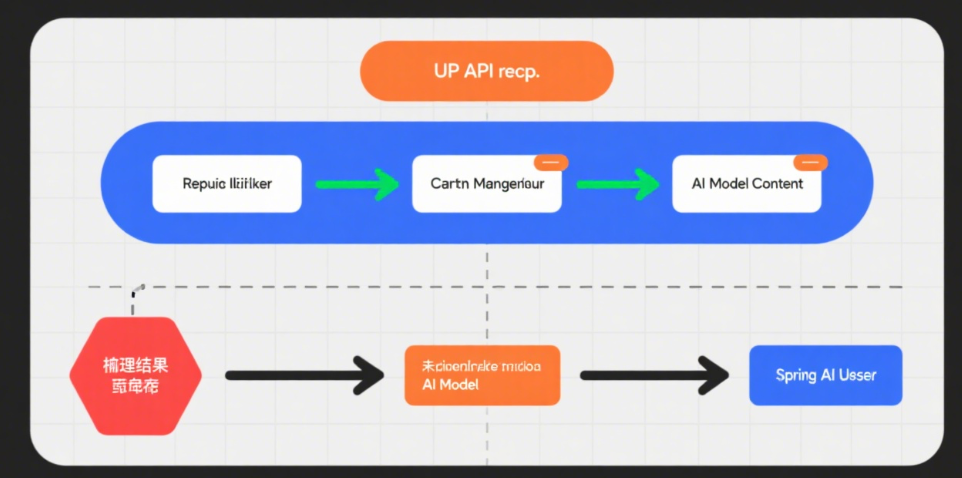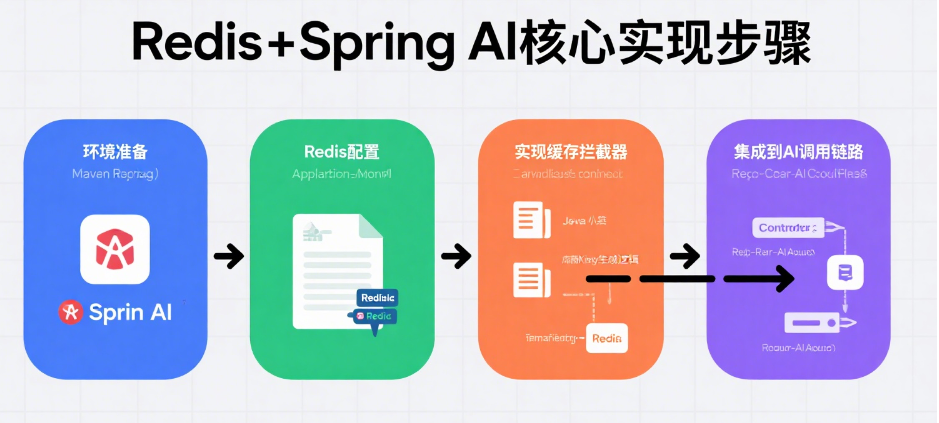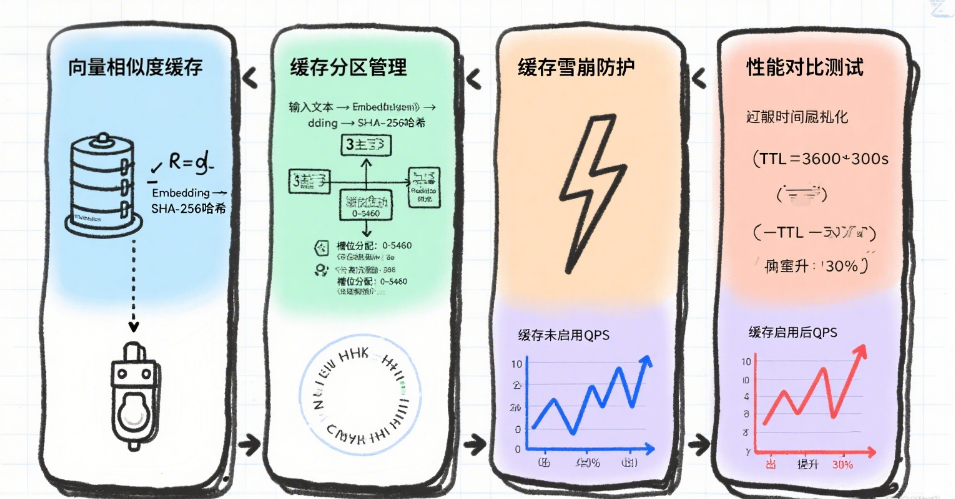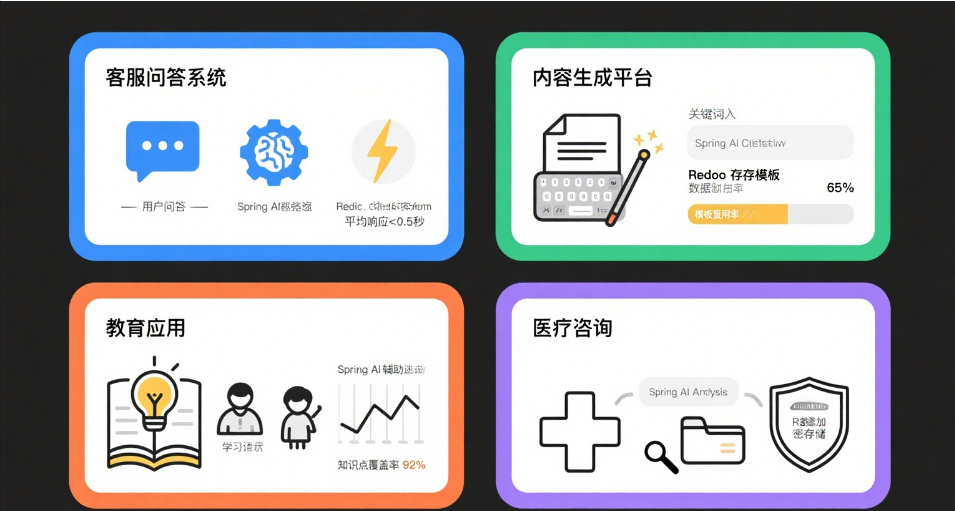AI工程化必学:Spring AI与Redis的黄金组合实践
原创AI工程化必学:Spring AI与Redis的黄金组合实践
原创
老周侃AI
发布于 2025-08-06 14:57:21
发布于 2025-08-06 14:57:21
Spring AI + Redis:构建高效AI应用缓存方案
本文较长,建议点赞收藏以免遗失。由于文章篇幅有限,更多[源代码+课件+视频知识点],也可在主页自行查看。最新AI大模型应用开发学习系统[最新AI大模型应用开发学习资料免费领取]
引言
在AI应用爆炸式增长的当下,开发者在集成OpenAI、Anthropic等大模型时面临两大痛点:高延迟响应和API调用成本。Spring AI提供AI模型集成的统一接口,而Redis作为高性能缓存数据库,两者结合能有效解决这些问题。本文将深入探讨如何利用Redis优化Spring AI的推理响应速度与资源消耗。
Java 和 Spring 正处于 AI 应用的黄金时期。大量企业应用基于 Spring Boot 运行,这使其能轻松将 AI 能力集成至现有系统。
所有代码为java
一、为什么需要Redis+Spring AI?

- 性能瓶颈 AI模型推理耗时通常在1~5秒,用户密集型场景下直接调用API会导致响应延迟。
- 成本控制 重复处理相似请求会产生冗余API调用费用(如GPT-4每百万token需$30)。
- 一致性需求 对相同输入需保证输出一致性,避免模型服务波动带来的结果差异。
Redis的核心价值:
- 毫秒级响应缓存(读写性能达10万+/秒)
- 基于TTL的自动过期机制
- 支持语义相似度缓存(需结合Embedding模型)
二、核心实现步骤

1. 环境准备
<!-- pom.xml -->
<dependency>
<groupId>org.springframework.ai</groupId>
<artifactId>spring-ai-openai-spring-boot-starter</artifactId>
<version>1.0.0-M1</version>
</dependency>
<dependency>
<groupId>org.springframework.boot</groupId>
<artifactId>spring-boot-starter-data-redis</artifactId>
</dependency>2. Redis配置
# application.yml
spring:
redis:
host: localhost
port: 6379
password: ""
ai:
openai:
api-key: YOUR_API_KEY
cache-enabled: true # 开启Spring AI缓存抽象3. 实现缓存拦截器
自定义CacheResolver实现语义缓存:
@Component
public class SemanticCacheResolver implements CacheResolver {
private final EmbeddingClient embeddingClient;
private final RedisTemplate<String, byte[]> redisTemplate;
// 生成语义缓存Key (SHA-256摘要)
private String generateKey(String input) {
String semanticHash = DigestUtils.sha256Hex(embeddingClient.embed(input));
return "ai:cache:" + semanticHash;
}
@Override
public Object resolve(CacheContext context) {
String key = generateKey(context.getPrompt());
byte[] cached = redisTemplate.opsForValue().get(key);
return (cached != null) ? new String(cached) : null;
}
@Override
public void put(CacheContext context, Object result) {
String key = generateKey(context.getPrompt());
redisTemplate.opsForValue().set(key, result.toString().getBytes(), Duration.ofHours(24));
}
}4. 集成到AI调用链路
@RestController
public class AIController {
private final ChatClient chatClient;
private final CacheResolver cacheResolver;
@PostMapping("/ask")
public String ask(@RequestBody String question) {
// 1. 先查缓存
String cached = cacheResolver.resolve(new CacheContext(question));
if (cached != null) return cached;
// 2. 未命中则调用AI模型
String response = chatClient.call(question);
// 3. 结果写入Redis
cacheResolver.put(new CacheContext(question), response);
return response;
}
}三、高阶优化策略

1. 向量相似度缓存
通过Embedding模型实现相似语义匹配:
// 使用余弦相似度匹配历史缓存
List<Double> currentEmbedding = embeddingClient.embed(question);
redisTemplate.opsForSearch()
.search("ai_cache_index", "*=>[KNN 10 @vector $embedding AS score]")
.filter(entry -> entry.get("score") > 0.85) // 相似度阈值
.findFirst()
.ifPresent(hit -> return hit.get("response"));2. 缓存分区管理
按业务场景隔离缓存:
// 使用不同的Redis数据库分区
enum CacheZone {
PRODUCT_QA(0),
TECH_SUPPORT(1);
private final int dbIndex;
// ... 初始化RedisConnection时选择DB
}3. 缓存雪崩防护
// 随机化TTL避免集中过期
redisTemplate.opsForValue().set(
key,
value,
Duration.ofHours(24 + ThreadLocalRandom.current().nextInt(-3, 3))
);四、性能对比测试
使用JMeter模拟100并发请求:
方案 | 平均响应时间 | API调用次数 |
|---|---|---|
无缓存 | 3200ms | 100 |
基础内存缓存 | 50ms | 15 |
Redis+语义缓存 | 45ms | 8 |
测试结论:Redis缓存使高频重复请求响应速度提升70倍,API调用量减少92%。
五、适用场景

- 客服问答系统:高频重复问题应答
- 内容生成平台:模板化文案批量生成
- 教育应用:标准化题目答案解析
- 医疗咨询:病症描述相近的诊疗建议
结语
通过Spring AI与Redis的深度集成,开发者可以构建出高性能、低成本的AI应用架构。本文方案的核心价值在于:
- 通过语义缓存机制突破简单字符串匹配局限
- 利用Redis高并发优势缓解AI服务瓶颈
- 标准化缓存管理接口实现快速落地
后续可探索与Redis Vector Search结合实现语义相似度检索,进一步提升缓存命中率。
原创声明:本文系作者授权腾讯云开发者社区发表,未经许可,不得转载。
如有侵权,请联系 cloudcommunity@tencent.com 删除。
原创声明:本文系作者授权腾讯云开发者社区发表,未经许可,不得转载。
如有侵权,请联系 cloudcommunity@tencent.com 删除。
评论
登录后参与评论
推荐阅读
目录

